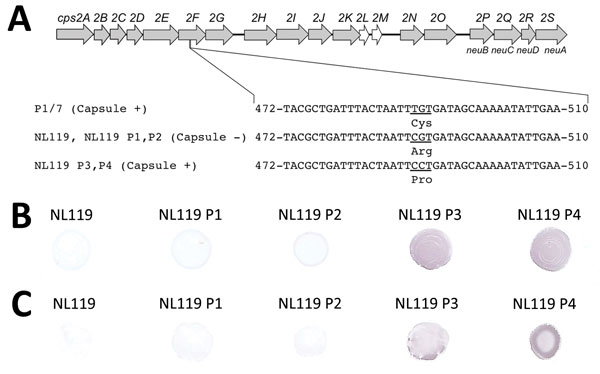Volume 22, Number 10—October 2016
Dispatch
Streptococcus suis Serotype 2 Capsule In Vivo
Figure 1

Figure 1. Capsule recovery of Streptococcus suis strain NL119 in vivo. A) The genetic organization of the S. suis serotype 2 capsular polysaccharide synthesis (cps) gene cluster and mutations observed in isolate NL119 and strains retrieved from NL119-infected mice after each in vivo passage (NL119 P1–P4; DDBJ/EMBL/GenBank accession nos. LC147077, LC147078, LC147079, LC147080, and LC077855, respectively). Gray arrows indicate genes putatively involved in capsule synthesis; open arrows indicate genes with unknown functions; numbers indicate nucleotide positions in cps2F. NL119 lost the ability to synthesize the capsule because of a missense mutation at nt 490 (T490C, Cys164Arg) of cps2F (4). B, C) NL119 P1 and P2 retrieved from mice after the first and second in vivo passages, remained nonencapsulated, and their cps2F sequences were identical to that of NL119. In NL119 P3 and P4 retrieved after the third and fourth passages, a further missense mutation at nt 491 (G491C, Arg164Pro) of cps2F restored the function of the gene, resulting in capsule recovery of the strains. Dot-ELISA of NL119 and strains retrieved from NL119-infected mice after each in vivo passage (NL119 P1–P4) using monoclonal antibody Z3 (B) and polyclonal anti–S. suis serotype 2 serum adsorbed with NL119 (C). Monoclonal antibody Z3 specifically recognizes the sialic acid moiety of the S. suis serotype 2 capsule.
References
- Gottschalk M. Streptococcosis. In: Zimmerman JJ, Karriker LA, Ramirez A, Schwartz KJ, Stevenson GW, editors. Diseases of swine, 10th ed. Ames (IA): John Wiley & Sons, Inc.; 2012. p. 841–55.
- Onishi H, Sugawara M, Okura M, Osaki M, Takamatsu D. Prevalence of Streptococcus suis genotypes in isolates from porcine endocarditis in East Japan. J Vet Med Sci. 2012;74:1681–4.DOIPubMedGoogle Scholar
- Lakkitjaroen N, Takamatsu D, Okura M, Sato M, Osaki M, Sekizaki T. Loss of capsule among Streptococcus suis isolates from porcine endocarditis and its biological significance. J Med Microbiol. 2011;60:1669–76.DOIPubMedGoogle Scholar
- Lakkitjaroen N, Takamatsu D, Okura M, Sato M, Osaki M, Sekizaki T. Capsule loss or death: the position of mutations among capsule genes sways the destiny of Streptococcus suis. FEMS Microbiol Lett. 2014;354:46–54.DOIPubMedGoogle Scholar
- Fittipaldi N, Segura M, Grenier D, Gottschalk M. Virulence factors involved in the pathogenesis of the infection caused by the swine pathogen and zoonotic agent Streptococcus suis. Future Microbiol. 2012;7:259–79.DOIPubMedGoogle Scholar
- Håkansson S, Bergholm A-M, Holm SE, Wagner B, Wagner M. Properties of high and low density subpopulations of group B streptococci: enhanced virulence of the low density variant. Microb Pathog. 1988;5:345–55.DOIPubMedGoogle Scholar
- Patrick S, Reid JH. Separation of capsulate and non-capsulate Bacteroides fragilis on a discontinuous density gradient. J Med Microbiol. 1983;16:239–41.DOIPubMedGoogle Scholar
- Charland N, Jacques M, Lacouture S, Gottschalk M. Characterization and protective activity of a monoclonal antibody against a capsular epitope shared by Streptococcus suis serotypes 1, 2 and 1/2. Microbiology. 1997;143:3607–14.DOIPubMedGoogle Scholar
- Okura M, Osaki M, Fittipaldi N, Gottschalk M, Sekizaki T, Takamatsu D. The minor pilin subunit Sgp2 is necessary for assembly of the pilus encoded by the srtG cluster of Streptococcus suis. J Bacteriol. 2011;193:822–31.DOIPubMedGoogle Scholar
- Benga L, Goethe R, Rohde M, Valentin-Weigand P. Non-encapsulated strains reveal novel insights in invasion and survival of Streptococcus suis in epithelial cells. Cell Microbiol. 2004;6:867–81.DOIPubMedGoogle Scholar
- Bonifait L, Gottschalk M, Grenier D. Cell surface characteristics of nontypeable isolates of Streptococcus suis. FEMS Microbiol Lett. 2010;311:160–6.DOIPubMedGoogle Scholar
- Tanabe S, Bonifait L, Fittipaldi N, Grignon L, Gottschalk M, Grenier D. Pleiotropic effects of polysaccharide capsule loss on selected biological properties of Streptococcus suis. Can J Vet Res. 2010;74:65–70.PubMedGoogle Scholar
1These authors contributed equally to this article.